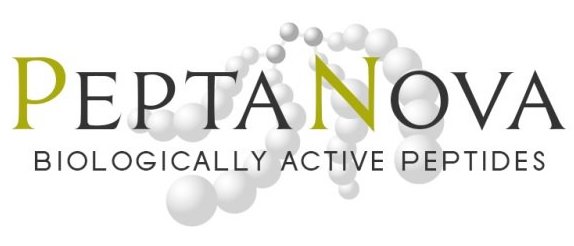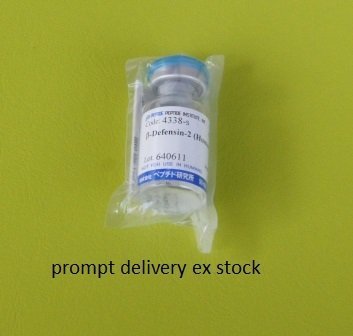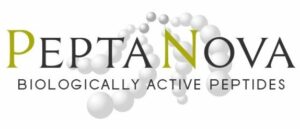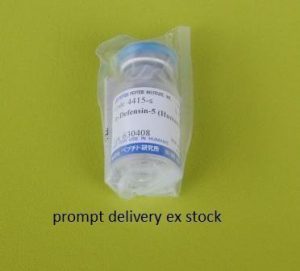Beta-Defensin-3 (Human)
hBD-3 | Human β-Defensin-3
4382-s 0.1 mg | 285.00 EUR
Synthetic Product (disulfide bonds between Cys11-Cys40, Cys18-Cys33 and Cys23-Cys41)
Gly – Ile – Ile – Asn – Thr – Leu – Gln – Lys – Tyr – Tyr – Cys – Arg – Val – Arg – Gly – Gly – Arg – Cys – Ala – Val – Leu – Ser – Cys – Leu – Pro – Lys – Glu – Glu – Gln – Ile – Gly – Lys – Cys – Ser – Thr – Arg – Gly – Arg – Lys – Cys – Cys – Arg – Arg – Lys – Lys
| (M.W. 5155.1) | C216H371N75O59S6 |
The purity of Human Beta-Defensin-3 is guaranteed to be higher than 99% by HPLC
| Download: PDF-data-sheet |
Antimicrobial Peptide / Staphylococcus aureus-Killing Factor
The human defensin peptides represent a new and important family of antimicrobial peptides. The defensin peptides are grouped in two subfamilies, the alpha-Defensins such as human alpha-defensin-1 (HNP-1, Code 4271-s) and the beta-Defensin (hBD) family.
The discovery of two new antimicrobial peptides described as human beta-defensin-1 (hBD-1, Code 4337-s) and human beta-defensin-2 (hBD-2, Code 4338-s) was followed by the description of Human Beta-Defensin-3.
HBD-3 was identified in skin of psoriac disease patients, from which hBD-2 was also isolated. Beta-Defensin-3 was described by peptide chemical methods as a polypeptide composed of 45 amino acid residues and three distinct disulfide bridges.
The antimicrobial activity of hBD-3 is characterised by:
- a broad spectrum of antimicrobial activity against many pathogenic microbes such as multi resistant Staphylococcus aureus and vancomycin-resistant Enterococcus faecium without hemolytic activity,
- salt-intesnity up to 200nM NaCl,
- expression of activity through cell wall perforation, and
- regulation of TNF-α and contact with bacteria.
In solution, an amphipatic dimeric structure was assumed for hBD-3. This is quite different from the proposed structures of hBD-1 and hBD-2. This different structure of hBD-3 compared to those of hBD-1 and hBD-2 might be the reason for the differences in the bacterial activity against Staphylococcus aureus.
References:
- T. Harder, J. Bartels, E. Christophers and J.M. Schröder, J. Biol. Chem., 276, 5707 (2001) (Original description of beta-defensin-3)
- J.R.C. Garcia, F. Jaumann, S. Schulz, A. KrauseJ. Rodringuez-Jiménez, U. Forssmann, K. Adermann, E. Klüver, C. Vogelmeier, D. Becker, R. Hedrich, W.G. Forssmann and R. Bals, Cell. Tissue. Res., 306, 257 (2001) (Original; Amino-Terminally Truncated Peptide)
- L.A. Duits, M. Rademaker, B. Ravensberger, M.A.J.A. van Sterkenburg, E. van Strijen, P.S. Hiemstra and P.H. Nibbering, Biochem. Biophys. Res. Commun., 280, 522 (2001) (Pharmacology)
- H.P.Ija, B.C. Schutte, A. Schudy, R. Linzmeier, J.M. Guthmiller, G.K. Johnson, B.F. Tack, J.P. Mitros, A. Rosenthal, T. Ganz and P.B. McCray, Jr., Gene, 263, 211 (2001) (DNA Sequenz / Tissue Distribution)
- D.J Schibli, H.N. Hunter, V. Aseyev, T.D. Starner, J.M. Wiencek, P.B. McCray, Jr., B.F. Tack, and H.J. Vogel, J. Biol. Chem., 277, 8279 (2002) (Solution Structure of hBD-3)
Links to publications that use our peptide beta-Defensin-3 | code 4382-s:
- β-Defensins chemoattract macrophages and mast cells but not lymphocytes and dendritic cells: CCR6 is not involved
- Differential activity of innate defense antimicrobial peptides against Nocardia species
For Laboratory use only!



